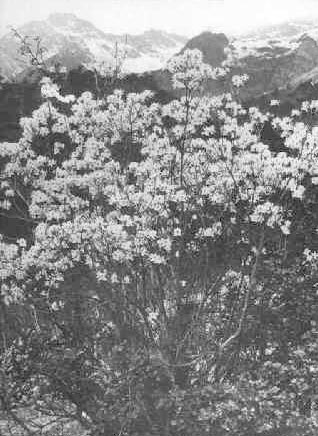The Dr. Rock Rhododendron Seeds

|
|
Fig. 2.
R. chartophyllum
var.
praecox
at 12.500 ft. Rock photo |
Reports from members who sowed seeds from the Dr. Joseph Rock expedition have been most enthusiastic. All the rhododendron seeds sent back were viable and have sprouted well, with the exception of one or two numbers. One envelope contained seed capsule hulls and chaff, but no seeds. Several other numbers have failed to germinate or have sent up a small percentage of plants.
It is remarkable that seeds gathered from so many different locations (Fig. 2) and altitudes have sprouted almost in unison. Many of the small plants sowed from seed in February already show distinct characterizations. Lepidotes and elepidotes are discernible even at this early age. Some small plants are quite glandular on leaf margin and stem and small hairs are present on the upper surface of the tiny leaves of many.
Most of the seeds gathered are from right in the heart of "Rhodoland" a term applied to this section by Mr. Kingdon Ward in his book "Rhododendrons," and there will be many fine plants among them.
Members and gardeners alike should undertake the growing of a number of these species sent back by Dr. Rock.
A greenhouse is not necessary to raise fine seedlings, but a small cold frame, even a single sash will afford the protection needed for a year or so by the small plants. Most of the damage to small seedlings is caused by drying winds and low humidity in the dry months of Summer, and if a gardener misses a turn at watering the plants could be lost. Glass protection will keep a high humidity and keep the plants moist for a longer period of time. After the first year the plants will have established a root system and, be able to withstand the dry summer in the open.
Mr. John Bacher In his address before the American Rhododendron Society in May advised against planting seeds now during the Summer, but rather to wait until Winter when seeds can be planted safely. Rhododendron seeds remain viable for a number of years if properly stored. Mr. Bacher did recommend the growing of plants sprouted in February, for they can safely be transplanted now into flats and grown on successfully.
The American Rhododendron Society has at this time on hand, small plants of all the numbers sent lack by Dr. Rock and anyone interested in growing them is advised to write the Secretary of the American Rhododendron Society.